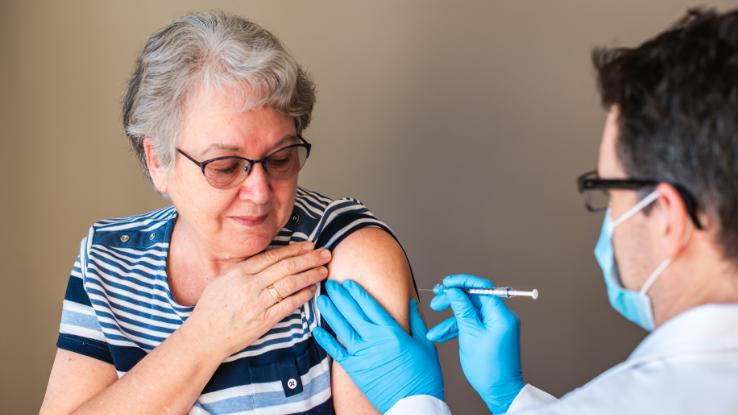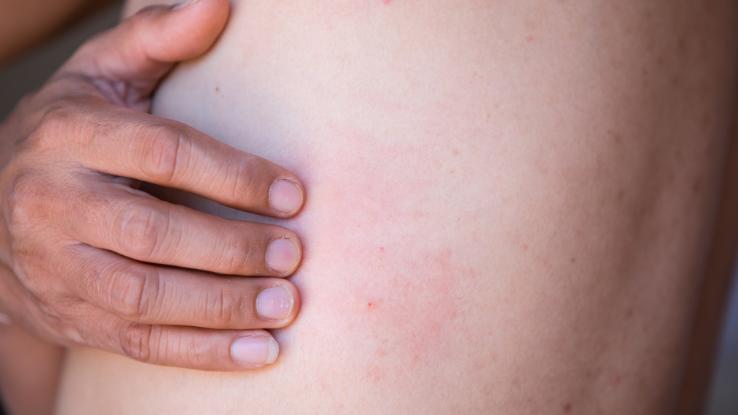Shingles 101: How Chickenpox Can Lead to This Skin Condition

Caused by a virus, shingles, also known as herpes zoster, is a painful condition that results in concentrated skin rashes and blisters. The varicella-zoster virus, the virus that causes shingles, is also responsible for chickenpox. This means that individuals who have developed chickenpox retain the varicella-zoster virus, potentially leading to shingles later in life.
What Is Shingles?
Once a person has contracted chickenpox, the varicella-zoster virus remains dormant — that is, it remains in the body without showing symptoms — in certain nerves of the body. In some cases, the virus stays dormant for the remainder of a person’s life. In others, however, the virus can become active again and lead to the development of shingles years or decades after the initial chickenpox infection.
The incidence of shingles in young, healthy individuals ranges between 1.2 and 3.4 per 1000 people per year. Among those older than 65 years old, the incidence is between 3.9 and 11.8 per 1000 people per year. In the United States, about one in every three individuals will experience shingles in their lifetime.
The signature shingles rash most often appears on just one side of the body — around the waistline or side of the trunk, or around one eye. While shingles is not considered a life-threatening virus, it can be quite painful. Moreover, early treatment is crucial to prevent potential complications.
Signs & Symptoms of Shingles
Many shingles patients experience intensely painful skin, tingling, or numbness before they develop a rash or blisters. Red patches on the skin will follow the initial symptoms, along with blisters contained to a single stripe of the body that follows a nerve line. These blisters might burst, forming ulcers that are dry and crusted. This crust should fall off on its own within two to three weeks, and rarely causes permanent scarring.
Most commonly, the signature shingles rash occurs around (or on) the waistline, trunk, face, and ears. Other symptoms include:
- Fever, chills, and body aches
- Abdominal pain
- Joint pain
- Drooping eyelids
- Hearing or vision issues
- Fatigue
- Headaches
What Causes Shingles?
Shingles is caused by the varicella-zoster virus becoming active again after lying dormant for years following a person’s recovery from chickenpox. The exact cause for the reactivation of the varicella-zoster virus remains unknown, however there are certain factors that may put a person at an increased risk of developing shingles. In most cases, only one outbreak will occur.
Risk factors for developing shingles include:
- Being above the age of 50
- Contracting chickenpox during infancy
- A weakened immune system due to a chronic illness or medications
- Chronic emotional stress
- Having cancer or a malignant tumor
A person with shingles is contagious to those who do not have chickenpox immunity through direct contact with open sores. Once the virus has been passed on to another person, the recipient will develop the chickenpox as opposed to shingles. People who have had the chickenpox are not at risk of catching shingles.
If you have shingles, you should avoid contact with those who are elderly, pregnant individuals, babies, and young children. Moreover, you should also avoid people who have weakened immune systems.
Prevention
Anyone who has had chickenpox is at risk of developing shingles later in life. However, you can get a shingles vaccine to prevent its occurrence or lessen its effects. Per the recommendation of the Centers for Disease Control and Prevention, adults over the age of 50 should get the shingles vaccine known as Shingrix, given in two doses, two to six months apart. This vaccine was approved in the United States in 2017 and is 90% effective against the onset of shingles.

How Shingles Is Diagnosed?
Doctors are typically able to diagnose shingles visually through a physical examination, coupled with information taken from your past medical history. In some rare cases, a skin sample may be needed. However, the telltale signs of blisters and rashes over a particular area of a person’s skin is usually enough to identify shingles.
Shingles Treatment
While there is no specific cure for shingles, early treatment with antiviral medication is important for preventing complications and speeding up the healing process. Common medications used to treat shingles include:
- Acyclovir
- Valacyclovir
- Famciclovir
If you start to feel pain in your skin or burning sensations, call your healthcare provider so that you can start these medications as early as possible. These medications are typically taken in oral form, although some individuals may require the medicine intravenously (through an IV).
A healthcare provider may also recommend the following for home care:
- Cold compresses to help reduce pain
- Colloidal oatmeal baths and calamine lotion to reduce itching
- Oral pain relief medications
- Topical numbing agents to help reduce pain and itching
- Plenty of rest
- Keeping the skin clean
- Isolating the infected person from those who may develop severe complications if they are exposed to the virus, such as pregnant people or elderly folks
Possible Complications
Although it is not considered a life-threatening condition, complications from shingles can be long-lasting and affect a person’s quality of life. Some common complications include the following:
- Impaired Vision: If a person’s shingles outbreak occurs in or around the eye area, it is known as ophthalmic shingles and can cause quite serious lasting effects such as vision loss or blindness.
- Persistent Neurological Problems: The virus that causes shingles spreads to the skin through nerves. As there are nerves nearly everywhere in the body, shingles has the potential to spread to areas such as the face (leading to potential facial sensation loss or paralysis), the brain (causing inflammation of the brain), or the inner ear (leading to hearing loss or deafness).
- Continued Pain: The pain from shingles blisters can continue even after the blisters have resolved. This is a condition known as postherpetic neuralgia, and is due to nerves sending stronger-than-normal pain signals to your skin.
- Infections: If you do not receive adequate treatment for your shingles blisters, or continually scratch them (thus preventing healing from occurring), you may be at risk for developing a bacterial skin infection.
Next Steps
If you are currently experiencing a localized rash or a burning sensation of the skin on one side of the body, contact your healthcare provider right away to find out treatment options that may prevent long-term complications of shingles. If you are over the age of 50, talk with your healthcare provider to find out more about the shingles vaccine.
Resource Links:
- “Shingles” via Mayo Clinic
- “About Shingles (Herpes Zoster)” via Centers for Disease Control and Prevention (CDC)
- “Shingles” via Medline Plus
- “Herpes Zoster” via National Center for Biotechnology Information (NCBI)





